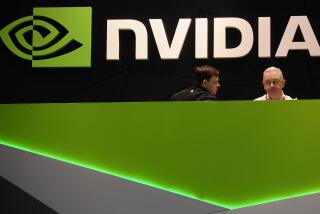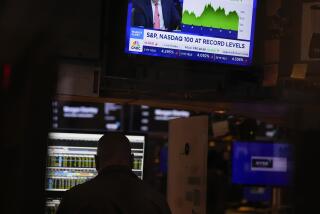Your Money : Stock Picking With Sophisticated Software
Imagine you had 4,000 securities analysts at your command, sifting through investment information around the clock in hope of finding the best stocks at the cheapest prices.
Further suppose that you didn’t have to pay these analysts, let alone supervise them, feed them or allow them any coffee breaks.
Dean Barr doesn’t have an army of 4,000 human analysts, but he speaks like he does. He manages a new small-stock mutual fund using a “neural network” computer programming model, an approach he says gives him the power of 4,000 analysts.
Barr manages the new Quantitative Disciplined Growth Fund, part of the Quantitative Group, a small fund family headquartered in Lincoln, Mass. Barr’s portfolio debuted in October and counts only about $1 million in assets so far. It will focus on finding inefficiently priced small stocks.
There’s nothing especially novel about fund managers using computers to aid in their research. Investors have been using PCs for years to screen thousands of stocks for those showing high earnings growth, low book values, insider trading and all sorts of other variables.
But neural-network modeling is different in that it is adaptive. Barr has programmed his computer to identify those factors that are making individual stocks move at any given moment. As market conditions change, so do the dominant investment factors.
“No single indicator works 100% of the time,” notes Barr.
Moreover, the computer is able to make evaluations after considering all sorts of information simultaneously--much like the human decision-making process. Computers are adept at performing trial-and-error calculations on a massive scale to discern subtle patterns.
The neural-network approach has already been applied in medicine, finance and other fields where pattern recognition is sought using information that appears random to the human eye or mind.
For example, neural networks have shown promise in spotting credit cards that have been stolen but not yet reported lost because the owners don’t realize they’re missing, Barr says. Before making large purchases on a stolen card, thieves tend to make small purchases on automatic-payment machines such as those at gas stations. These small purchases are an anonymous way for a thief to check whether the card has been canceled. The pattern of large and small transactions, along with other details, shows up in a pattern a computer can recognize.
Neural-network modeling is also making a name in the investment sphere.
Barr’s firm, LBS Capital Management of Clearwater, Fla., has been managing money with a neural-network slant for large institutional clients since 1988 and now counts $700 million in assets. The company’s alliance with the Quantitative Group marks its first foray into mutual funds.
Brad Lewis at Fidelity Investments of Boston is the groundbreaker here. He runs three mutual funds--Disciplined Equity, Small-Cap Stock and Stock Selector--with a neural-network approach.
Lewis inputs about 100 variables in his ever-changing model, with an emphasis on earnings. He has beaten the Standard & Poor’s 500 in each of the past five years and is running roughly in line with the market so far in 1994.
Barr says he focuses more closely on “bottoms-up” or company-specific information compared to Lewis, who tracks broad industry, market and economic patterns in addition to data on individual stocks.
The time may be ripe for further applications of neural-network programming in the investment sphere, for two reasons.
The first involves great advances in computing power, which have made today’s PCs as powerful as mainframes were several years ago.
The second involves the explosion of investment information in magazines, newspapers, financial broadcasts, research reports, studies and more. This is too much information for most stock pickers to handle, Barr believes. Neural-network models are able to cut through the chaff to get to the wheat.
But investors intrigued by this approach should realize that a computer’s pattern-recognition and predictive abilities depend on how well it is programmed and monitored by humans--the old “garbage in, garbage out” problem.
It’s particularly challenging to assign proper weights to the various investment variables so the neural-network model concentrates on the most important factors while minimizing others.
In the case of Quantitative Disciplined Growth, investors should be aware of some additional risks:
* The fund invests in smaller companies, which are prone to bigger price swings than the blue chips. This danger also applies to Fidelity Small-Cap Stock.
* Quantitative Disciplined Growth is a new portfolio run by a management team with no performance track record in the mutual fund arena.
* The fund is able to sell stocks short, a risky strategy that bets on falling stock prices.
* The fund’s per-share expenses are expected to be fairly high, in the range of about 2.1% annually, including a 0.5% 12b-1 marketing fee. That compares to an average of about 1.4% for stock funds. Lewis’ funds also had high pro-rata expenses early on, but they have come down as the portfolios gained assets and became more efficient.
Quantitative Disciplined Growth ((800) 331-1244) carries a 1% back-end sales charge. No-load shares are available for institutional investors. Fidelity ((800) 544-8888) levies a 3% load on Small-Cap Stock but no sales charge on the other two portfolios.
Barr predicts neural networks will gain greater acceptance in the investment community, though he believes there will always be a place for managers with top intuitive stock-picking skills.
“I still don’t think a computer can out-trade a human being,” he says.
More to Read
Inside the business of entertainment
The Wide Shot brings you news, analysis and insights on everything from streaming wars to production — and what it all means for the future.
You may occasionally receive promotional content from the Los Angeles Times.










